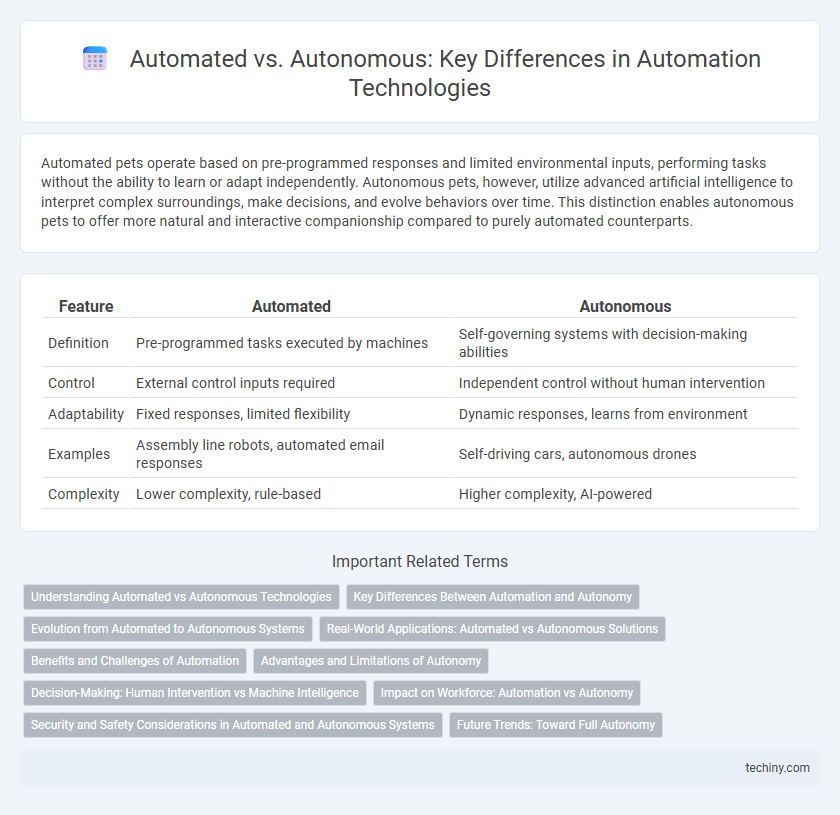Automated pets operate based on pre-programmed responses and limited environmental inputs, performing tasks without the ability to learn or adapt independently. Autonomous pets, however, utilize advanced artificial intelligence to interpret complex surroundings, make decisions, and evolve behaviors over time. This distinction enables autonomous pets to offer more natural and interactive companionship compared to purely automated counterparts.
Table of Comparison
| Feature | Automated | Autonomous |
|---|---|---|
| Definition | Pre-programmed tasks executed by machines | Self-governing systems with decision-making abilities |
| Control | External control inputs required | Independent control without human intervention |
| Adaptability | Fixed responses, limited flexibility | Dynamic responses, learns from environment |
| Examples | Assembly line robots, automated email responses | Self-driving cars, autonomous drones |
| Complexity | Lower complexity, rule-based | Higher complexity, AI-powered |
Understanding Automated vs Autonomous Technologies
Automated technologies perform pre-programmed tasks without deviation, relying on human input for decision-making and control, whereas autonomous technologies possess the ability to perceive, learn, and make independent decisions using artificial intelligence and machine learning algorithms. Understanding automated versus autonomous systems is critical in applications such as manufacturing, transportation, and robotics, as it influences system design, safety protocols, and operational efficiency. The distinction between these technologies drives advancements in smart systems, including self-driving vehicles and industrial robots, enhancing productivity and reducing human intervention.
Key Differences Between Automation and Autonomy
Automation involves pre-programmed tasks executed without real-time decision-making, while autonomy incorporates adaptive learning and environmental interaction to independently modify actions. Automated systems follow fixed rules for repetitive processes, whereas autonomous systems employ sensors and AI to navigate complex scenarios and improve performance over time. The key difference lies in adaptability: automation executes predefined instructions, and autonomy enables self-governed, intelligent responses.
Evolution from Automated to Autonomous Systems
Automated systems execute predefined tasks based on specific instructions, while autonomous systems evolve by integrating advanced AI and machine learning to make real-time decisions without human intervention. The evolution from automated to autonomous is driven by improvements in sensor technology, data analytics, and adaptive algorithms that enable systems to understand complex environments and learn from interactions. This progression enhances operational efficiency, safety, and scalability across industries such as manufacturing, transportation, and robotics.
Real-World Applications: Automated vs Autonomous Solutions
Automated solutions perform specific, pre-programmed tasks with minimal human intervention, commonly seen in manufacturing assembly lines and robotic process automation. Autonomous solutions leverage advanced AI and sensor fusion to make decisions and adapt in real-time, prominently utilized in self-driving vehicles and smart drones for dynamic environments. Real-world applications highlight automated systems for repetitive, consistent operations while autonomous systems excel in complex, unpredictable scenarios requiring cognitive flexibility.
Benefits and Challenges of Automation
Automation enhances efficiency and accuracy by reducing human intervention in repetitive tasks, leading to cost savings and increased productivity across industries. Challenges include the initial investment in technology, potential job displacement, and the need for ongoing maintenance and updates to ensure system reliability. Balancing these factors is crucial for organizations aiming to leverage automation while managing workforce transitions and operational risks.
Advantages and Limitations of Autonomy
Autonomous systems offer significant advantages such as enhanced decision-making capabilities, real-time adaptability, and reduced human intervention, leading to increased efficiency and safety in complex environments. However, limitations include high development costs, challenges in handling unpredictable scenarios, and concerns over ethical and legal accountability. Balancing autonomy with robust oversight remains critical to maximizing benefits while mitigating risks in automation applications.
Decision-Making: Human Intervention vs Machine Intelligence
Automated systems operate based on pre-defined rules and require human intervention for decision-making when encountering exceptions or changes. Autonomous systems leverage advanced machine intelligence and artificial intelligence to independently analyze data, adapt to new conditions, and make complex decisions without human input. This distinction highlights the shift from automation as task execution towards autonomy as intelligent, self-directed operation in modern technology.
Impact on Workforce: Automation vs Autonomy
Automation streamlines repetitive tasks by following predefined instructions, enhancing workforce efficiency but potentially reducing manual labor demand. Autonomous systems, equipped with decision-making capabilities and adaptive learning, shift workforce roles toward oversight, strategy, and exception handling, fostering skill development and higher-level problem solving. This transition from automation to autonomy drives a workforce evolution from task execution to cognitive engagement, impacting job design and employee value.
Security and Safety Considerations in Automated and Autonomous Systems
Automated systems execute predefined tasks based on specific inputs, requiring constant supervision to ensure security and mitigate risks of unexpected behavior. Autonomous systems leverage machine learning and artificial intelligence to make independent decisions, raising concerns about system transparency, decision accountability, and adaptive cybersecurity measures. Implementing robust intrusion detection, fail-safe mechanisms, and continuous risk assessments is critical to maintaining safety and security across both automated and autonomous platforms.
Future Trends: Toward Full Autonomy
Future trends in automation emphasize the shift from automated systems, which perform predefined tasks, to fully autonomous technologies capable of independent decision-making and adaptation. Advances in artificial intelligence, machine learning, and sensor integration propel the development of autonomous vehicles, robotics, and smart manufacturing systems that operate with minimal human intervention. This progression promises increased efficiency, safety, and scalability across industries as autonomous systems evolve to handle complex and dynamic environments.
Automated vs Autonomous Infographic

 techiny.com
techiny.com